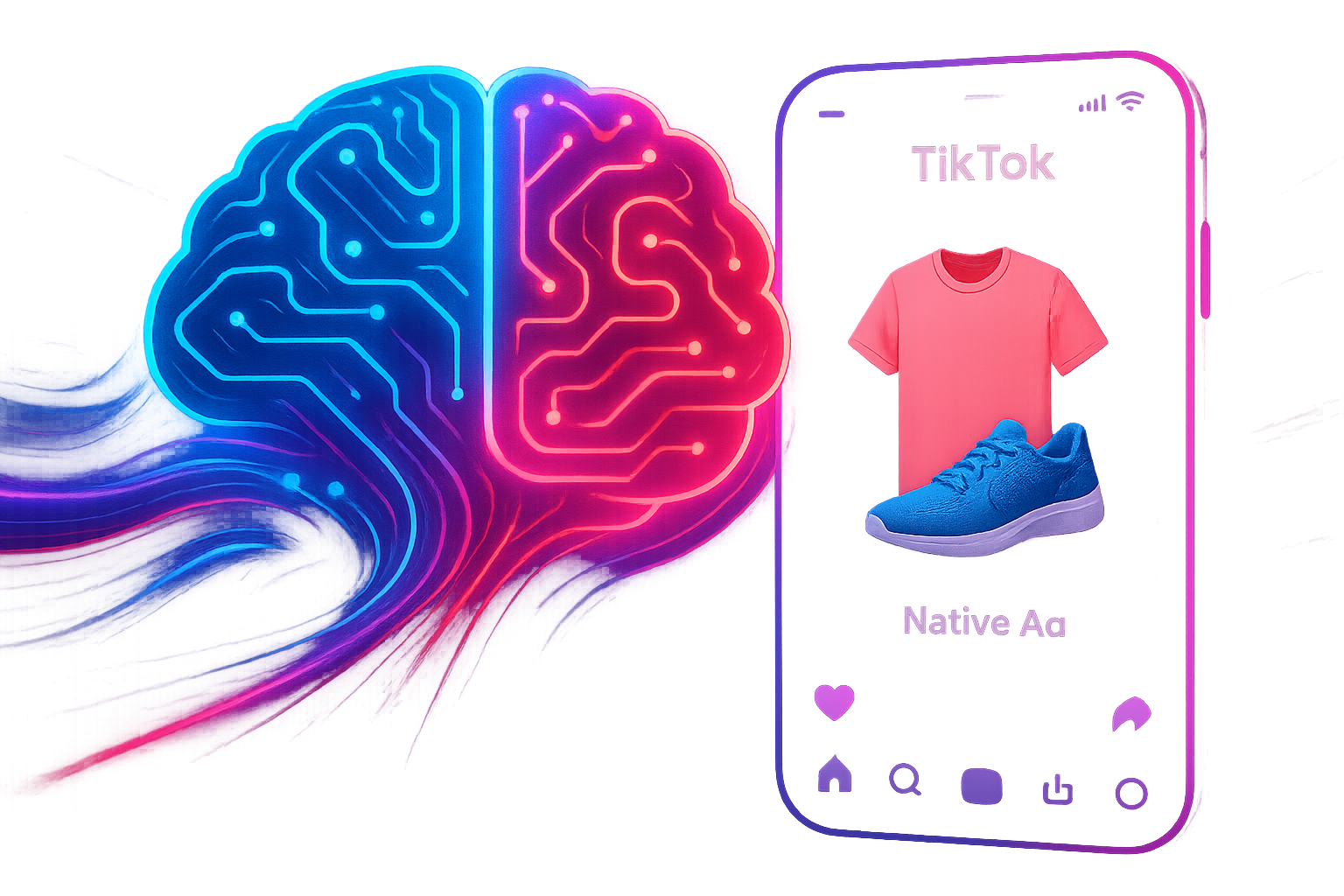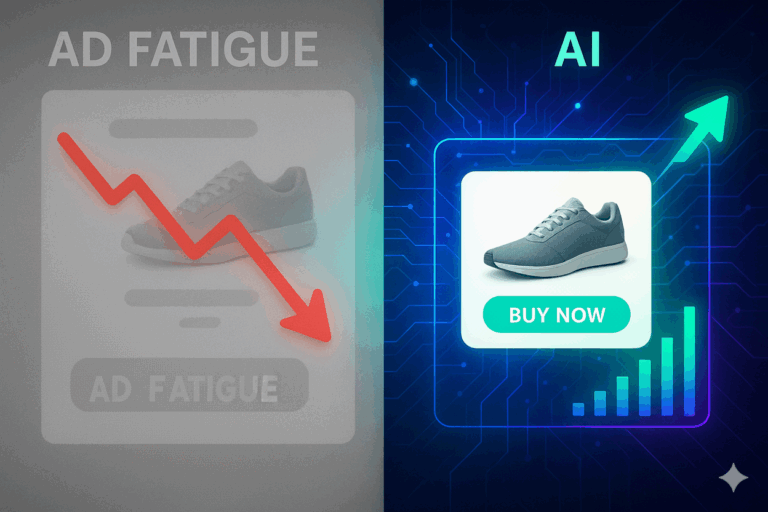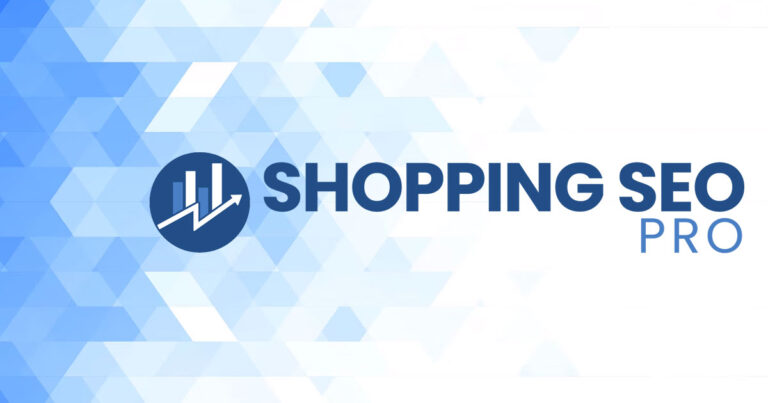Every eCommerce brand has felt it: you launch a new ad campaign on a platform like Meta, meticulously craft your audiences, and then… you wait. You hope the algorithm finds the right people. Sometimes it works. Often, it feels like you’re just feeding dollars into a machine, hoping for the best.
Now, consider TikTok. Its entire platform isn’t just using AI; it is AI. The “For You Page” (FYP) is one of the most powerful recommendation engines ever built. For advertisers, this changes everything. It means you’re not just hoping the algorithm finds your audience; you’re plugging your products directly into an engine designed for hyper-relevant discovery.
But “using TikTok’s AI” is a vague promise. Most guides tell you what buttons to click but not why they work. They show you trendy ad examples but don’t explain the AI mechanics that give those ads rocket fuel.
Here’s what this means for your brand: understanding how TikTok’s AI thinks is no longer a “nice-to-have.” It’s the difference between fighting for scraps and achieving rapid, scalable customer acquisition. Let’s pull back the curtain.
Decoding the “Black Box”: How TikTok’s Recommendation AI Actually Works
To win with TikTok ads, you first have to understand the battlefield—the “For You Page.” Unlike other platforms that rely heavily on a user’s social graph (who you follow), TikTok’s FYP is driven almost entirely by content analysis and user behavior.
Think of it like the world’s most intuitive personal shopper. It doesn’t just ask what you like; it watches what you do.
The Brain Behind the “For You Page”
TikTok’s AI builds a detailed profile on every user by analyzing hundreds of signals in real time. These aren’t just simple demographics. The AI tracks:
- Video Interactions: Which videos you watch to the end, re-watch, like, share, or comment on. A “completion rate” is a massive signal of interest.
- Content Analysis: The AI “watches” the videos you engage with. It analyzes the captions, hashtags, sounds, and even the objects and actions within the video itself using computer vision.
- User Behavior: It notes the accounts you follow, the sounds you save, and the effects you try.
- Device and Account Settings: Things like language preference, country setting, and device type help refine recommendations.
This creates a rich, constantly evolving interest graph for every single user. When you run an ad, you aren’t just targeting “women aged 25-34 who like skincare.” You’re reaching users whose behavior indicates they’re actively consuming skincare tutorials, following beauty creators, and engaging with “get ready with me” videos. Your ad doesn’t interrupt their feed; it fits right in.
How AI Makes Your Ads Feel Like Native Content
The true magic of TikTok is its ability to serve ads that feel like organic discoveries. The AI’s goal is to place your ad in a user’s feed so seamlessly that it feels like the next great video the algorithm found for them.
It achieves this by matching the signals from your ad creative (the music, pacing, visual style) with the user profiles most likely to engage with that type of content. This is why low-fi, user-generated style content often outperforms slick, high-production commercials. It speaks the AI’s native language.
Putting AI to Work: Your Toolkit in TikTok Ads Manager
Knowing how the algorithm thinks is step one. Step two is using the tools inside TikTok Ads Manager to influence it. This isn’t about tricking the AI; it’s about giving it the highest-quality information so it can do its job faster and more effectively.
Beyond Demographics: AI-Powered Audience Targeting
While you can start with broad demographic targeting, the real power comes from feeding the AI your own business intelligence.
- The TikTok Pixel is Non-Negotiable: This is the data pipeline from your website to TikTok’s AI. Every
ViewContent,AddToCart, andPurchaseevent teaches the algorithm exactly who your customers are. Without strong, clean pixel data, the AI is flying blind. - Lookalike Audiences: Once your pixel has enough data (e.g., 1,000 purchase events), you can create Lookalike Audiences. TikTok’s AI analyzes the shared characteristics and behaviors of your existing customers and finds millions of new users who “look” just like them. This is one of the fastest ways to scale.
- Smart Targeting: By feeding the AI high-quality product data through proprietary feed strategies, you give it more context to find the right buyers. When your product feed is optimized, the AI doesn’t just know you sell a “shirt”; it knows it’s a “vintage-style, oversized cotton t-shirt in beige,” allowing it to match with users showing intent for that specific style.
The Creative Factory: Automated Ad Generation and Optimization
One of the biggest hurdles for brands on TikTok is the sheer volume of creative needed to stay fresh. AI is closing this gap. TikTok’s own “Generate with AI” feature and other third-party tools can help you create and test ad variations at a scale that’s impossible for humans alone.
But the real opportunity isn’t just generating content; it’s AI-driven iteration. This is a critical distinction.
- AI Generation: You provide inputs (product images, selling points, a URL), and the AI outputs a video ad with scripts, voiceovers, and music.
- AI Optimization: The system automatically tests different combinations of these elements. It might test five different opening hooks, three different calls-to-action, and four different background tracks—all at once. It then analyzes real-time performance data (like watch time and click-through rate) to identify the winning combination and automatically reallocate budget to it.
This transforms advertising from a series of static A/B tests into a continuous, automated optimization loop.
Smart Money: AI-Driven Budget and Bidding
TikTok’s AI can also manage your budget and bidding strategy to maximize results. Features like Smart+ Campaigns allow the AI to automate targeting, creative, and bidding based on your specific goal, whether it’s conversions, reach, or app installs. For ecommerce, setting a “Gross Merchandise Value (GMV)” optimization goal tells the AI to find users who are not just likely to buy, but likely to spend more.
When AI Goes Wrong: Troubleshooting Your TikTok Campaigns
AI isn’t a magic wand. Sometimes campaigns underperform, and the “black box” can feel frustratingly opaque. Here are some of the most common problems and how to diagnose them.
Problem #1: “My ads aren’t finding the right people.”
- The Cause: The AI is likely working with weak or insufficient data. This often happens with new ad accounts, poorly configured pixels, or targeting that’s initially too narrow.
- The Solution:
- Audit Your Pixel: Ensure it’s firing correctly on all key events.
- Go Broader (At First): Start with broader targeting to give the AI enough data to learn. It will naturally narrow down to the best-performing segments on its own.
- Be Patient: The AI’s “learning phase” can take a few days and several dozen conversions to lock in on the right audience. Don’t kill campaigns too early.
Problem #2: “My AI-generated creatives feel stale or off-brand.”
- The Cause: Creative fatigue is real, and AI tools can sometimes produce generic-looking content. The AI lacks true brand context.
- The Solution: Use a “human-in-the-loop” approach. Let AI handle the heavy lifting of generating variations, but have your team provide the core strategic inputs. Supply the AI with your best-performing hooks, brand-approved messaging, and authentic user-generated content as a starting point. AI isn’t replacing strategy—it’s amplifying it. This is where advanced generative engine optimization (GEO) tactics come into play, ensuring even AI-generated content aligns with brand voice and search intent.
Problem #3: “My budget is disappearing with no results.”
- The Cause: This often points to a creative problem. Even the world’s best AI can’t make people buy from a boring or confusing ad.
- The Solution: Focus on the first three seconds. Your ad’s hook is everything. Test wildly different opening hooks. Is it a question? A surprising visual? A problem statement? Use AI to test these variations rapidly and find what captures attention immediately.
Frequently Asked Questions About AI in TikTok Ads
We get a lot of questions from brands just starting their journey. Here are answers to the most common ones.
What is AI in TikTok ads for ecommerce?
It refers to the machine learning systems that power nearly every aspect of the TikTok advertising platform. This includes the recommendation engine that decides who sees your ad, the automated tools that help you create and test video creatives, and the algorithms that optimize your budget for the best possible return.
How does TikTok’s algorithm work for ads?
In short, the algorithm matches your ad with users whose behavior indicates they will be most interested in it. It analyzes signals from the user (what they watch, like, and share) and signals from your ad (the visuals, sound, and text) to create a seamless, relevant experience that feels less like an ad and more like a discovery.
How do I use AI to create TikTok ads?
You can use TikTok’s built-in “Generate with AI” feature within Ads Manager. You provide product assets and text prompts, and the AI generates video scripts, voiceovers, and full video ads. The key is to use this as a starting point and continually test and refine the outputs.
What’s the difference between AI-generated creative and AI-driven optimization?
This is a crucial distinction. AI generation is the act of creating the ad content (the video, the script). AI optimization is the process of testing and improving that content. It involves the AI automatically running different versions of your ad, analyzing the performance data in real time, and shifting budget to the top-performing variations to maximize results.
Your Next Move: From Platform AI to Proprietary Advantage
Mastering the AI within TikTok’s platform is now table stakes for any ecommerce brand serious about growth. It allows you to acquire customers faster, more efficiently, and at a scale that was previously unimaginable.
The practical takeaway: Stop fighting the algorithm and start feeding it what it needs—clean data, a high volume of creative variations, and clear business goals.
As you scale, the next frontier involves moving beyond platform-native tools. Leading brands are now deploying custom AI agents for ecommerce that can orchestrate entire campaigns, monitor competitors, and optimize performance across multiple channels 24/7. But that journey starts here, by building a deep, practical understanding of the most powerful discovery engine on the internet today.



